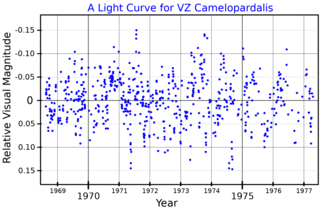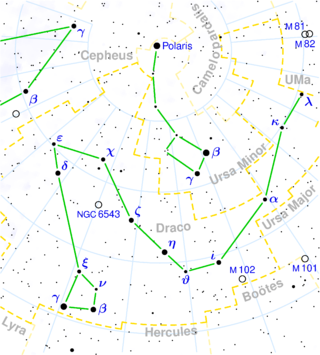Related Research Articles

BE Camelopardalis is a solitary variable star in the northern circumpolar constellation of Camelopardalis. It is visible to the naked eye as a faint, red-hued point of light with an apparent visual magnitude that fluctuates around 4.39. The star is located roughly 800 light years away from the Sun based on stellar parallax.

VZ Camelopardalis is a single, variable star in the northern circumpolar constellation of Camelopardalis. It has a reddish hue and is faintly visible to the naked eye with an apparent visual magnitude that fluctuates around 4.92. The star is located at a distance of approximately 500 light years from the Sun based on parallax, and is drifting further away with a radial velocity of +12 km/s. It was considered a member of the Hyades Supercluster, but in 1990 this was brought into question.

24 Capricorni or A Capricorni is a single star in the southern constellation of Capricornus. This object is visible to the naked eye as a faint, red-hued star with an apparent visual magnitude of +4.49. It is approximately 460 light years from the Sun, based on parallax. The star is moving further from the Earth with a heliocentric radial velocity of +32 km/s.

Upsilon Capricorni, Latinized from υ Capricorni, is a solitary star in the southern constellation of Capricornus. It has a reddish hue and is dimly visible to the naked eye with an apparent visual magnitude of 5.17. The star is about 730 light years from the Sun based on parallax, but is drifting closer with a radial velocity of −12 km/s. It is 0.22 degree north of the ecliptic, so is subject to lunar occultations.
HD 80230 is a single star in the southern constellation of Carina, near the northern constellation border with Vela. It has the Bayer designation g Carinae, while HD 80230 is the star's identifier in the Henry Draper catalogue. This is a suspected variable star with a brightness that has been measured varying from magnitude 4.31 down to 4.35, both of which is bright enough for the star to be visible to the naked eye. The distance to this object is approximately 490 light years based on parallax, but it is drifting closer to the Sun with a radial velocity of −5 km/s.

C1 Centauri is a single star in the southern constellation of Centaurus. It has the variable star designation V763 Centauri, while C1 Centauri is the Bayer designation. The star has a red hue and is dimly visibly to the naked eye with an apparent visual magnitude that fluctuates around +5.64. It is located at a distance of approximately 600 light years based on parallax, and has an absolute magnitude of −1.05. It is drifting further away with a radial velocity of +21 km/s. At one time it was a candidate member of the Zeta Herculis Moving Group but has since been excluded.
F Centauri is a suspected astrometric binary star system in the southern constellation of Centaurus. It has a reddish hue and is visible to the naked eye with an apparent visual magnitude that fluctuates around +5.01. The system is located at a distance of approximately 450 light years from the Sun based on parallax, and it has an absolute magnitude of −0.87. O. J. Eggen flagged this star as a member of the Hyades Supercluster.
HD 36678 is single star in the northern constellation of Auriga. This star is dimly visible to the naked eye with an apparent visual magnitude of 5.83. It is located at a distance of approximately 840 light years from the Sun based on parallax.

Tau1 Serpentis, Latinized from τ1 Serpentis, is a single star in the Caput (Head) segment of the equatorial constellation of Serpens. It is a red hued star that is dimly visible to the naked eye with an apparent visual magnitude of 5.16. Based upon parallax measurements, this star is located at a distance of approximately 990 light years from the Sun, while it is drifting closer with a radial velocity of −16.5 km/s.
HD 56618 is a single star in the southern constellation of Canis Major. It is a red-hued star that is faintly visible to the naked eye with an apparent visual magnitude of 4.66. This object is located at a distance of approximately 390 light years from the Sun based on parallax measurements. It is drifting further away with a radial velocity of +41.5 km/s, having come to within 203 light-years some 2.2 million years ago. Olin J. Eggen listed it as a probable member of the Hyades supercluster.
36 Comae Berenices is a single star in the northern constellation of Coma Berenices. It is faintly visible to the naked eye with an apparent visual magnitude of 4.76. The distance to this star, as determined from an annual parallax shift of 9.3 mas, is 349 light years. It is moving closer to the Earth with a heliocentric radial velocity of −1.5 km/s.

54 Eridani is a suspected astrometric binary star system located around 400 light years from the Sun in the equatorial constellation of Eridanus. It is visible to the naked eye as a faint, reddish hued star with a baseline apparent visual magnitude of 4.32. The object is moving closer to the Earth with a heliocentric radial velocity of −33 km/s.

42 Herculis is a single star located around 450 light years away from the Sun in the northern constellation of Hercules. It is visible to the naked eye as a faint, red-hued star with an apparent visual magnitude of 4.86. The star is moving closer to the Earth with a heliocentric radial velocity of −56 km/s.

104 Herculis is a solitary variable star located around 560 light years away from the Sun in the northern constellation of Hercules. It has the variable star designation V669 Herculis and the Bayer designation A Herculis, while 104 Herculis is the Flamsteed designation. This object is visible to the naked eye as a dim, red-hued point of light with a baseline apparent visual magnitude of 4.96. It is moving closer to the Earth with a heliocentric radial velocity of −1.2 km/s.
32 Ophiuchi is a single star located 410 light years away from the Sun in the constellation Hercules. It is visible to the naked eye as a dim, red-hued star with an apparent visual magnitude of 4.97. This is an aging red giant star on the asymptotic giant branch with a stellar classification of M3−III. Having exhausted the supply of hydrogen at its core it has expanded to 60 times the girth of the Sun. The star is radiating 614 times the luminosity of the Sun from its swollen photosphere at an effective temperature of around 3,712 K. It is moving further away from the Sun with a heliocentric radial velocity of +43 km/s.
HD 92036 is a single star in the equatorial constellation of Hydra. Its apparent magnitude is 4.87. This is an aging red giant star on the asymptotic giant branch with a stellar classification of M1III:Ba0.5.
HD 85951, formally named Felis, is a solitary orange hued star in the constellation Hydra. It has an apparent magnitude of 4.94, making it faintly visible to the naked eye under ideal conditions. Based on parallax measurements, the object is about 570 light-years away from the Sun and is receding with a heliocentric radial velocity of 50 km/s.

55 Pegasi is a single star in the northern constellation of Pegasus. It is visible to the naked eye as a faint, reddish-hued point of light with a baseline apparent visual magnitude of 4.51. The star is located approximately 302 light years away from the Sun based on parallax, but it is moving closer with a radial velocity of −5 km/s.
DU Lyncis is a single variable star in the constellation Lynx. It is a faint star but visible to the naked eye with an apparent visual magnitude of 5.15. With an annual parallax shift of 9.2 mas, it is located some 350 light years from the Sun. The star is moving closer with a heliocentric radial velocity of −37 km/s.

64 Draconis is a single star in the northern circumpolar constellation of Draco, located 452 light years away. It has the Bayer designation of e Draconis; 64 Draconis is the Flamsteed designation. The object is visible to the naked eye as a dim, red-hued star with an apparent visual magnitude of 5.27. It is moving closer to the Earth with a heliocentric radial velocity of −36 km/s, and it is predicted to come as close as 204 ly in around 4.3 million years.
References
- 1 2 3 4 5 6 7 8 9 10 11 Brown, A. G. A.; et al. (Gaia collaboration) (August 2018). "Gaia Data Release 2: Summary of the contents and survey properties". Astronomy & Astrophysics . 616. A1. arXiv: 1804.09365 . Bibcode: 2018A&A...616A...1G . doi: 10.1051/0004-6361/201833051 . Gaia DR2 record for this source at VizieR.
- 1 2 3 4 5 6 Anderson, E.; Francis, Ch. (2012), "XHIP: An extended hipparcos compilation", Astronomy Letters, 38 (5): 331, arXiv: 1108.4971 , Bibcode:2012AstL...38..331A, doi:10.1134/S1063773712050015, S2CID 119257644.
- ↑ "HD 180450". SIMBAD . Centre de données astronomiques de Strasbourg . Retrieved 2021-10-14.
- ↑ Eggleton, P. P.; Tokovinin, A. A. (September 2008), "A catalogue of multiplicity among bright stellar systems", Monthly Notices of the Royal Astronomical Society, 389 (2): 869–879, arXiv: 0806.2878 , Bibcode:2008MNRAS.389..869E, doi:10.1111/j.1365-2966.2008.13596.x, S2CID 14878976.
- ↑ Sinnott, Roger W.; Perryman, Michael A. C. (1997), Millennium Star Atlas, vol. 3, Sky Publishing Corporation and the European Space Agency, p. 1174, ISBN 0-933346-84-0.
- ↑ Eggen, Olin J. (July 1992), "Asymptotic giant branch stars near the sun", Astronomical Journal, 104 (1): 275–313, Bibcode:1992AJ....104..275E, doi:10.1086/116239.